| Depending on the island a fruit can have a different name, for example Mammy Apple (St Vincent) while other island(s) called it Mamisiporte which is a soft fruit the size of an avacado which has a faint smell and taste. | |||||||
Ackee (Achee, Akee, Blighia Sapida)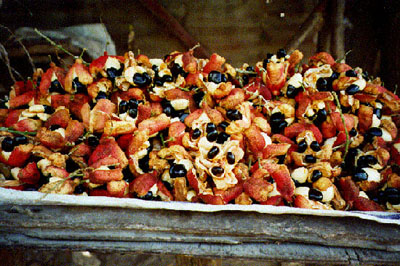 A handful of islands grow ackee as an ornamental tree, but only Jamaica looks at it as a tree that bears edible fruit.. A bright red tropical fruit that, when ripe, bursts open to reveal three large black seeds attached
individually to a soft, creamy yellow flesh. The tree grows about 9 metres (30 feet) tall. Ackee is poisonous if eaten before it is fully mature and because of its toxicity.
A handful of islands grow ackee as an ornamental tree, but only Jamaica looks at it as a tree that bears edible fruit.. A bright red tropical fruit that, when ripe, bursts open to reveal three large black seeds attached
individually to a soft, creamy yellow flesh. The tree grows about 9 metres (30 feet) tall. Ackee is poisonous if eaten before it is fully mature and because of its toxicity.
| |||||||
Abricot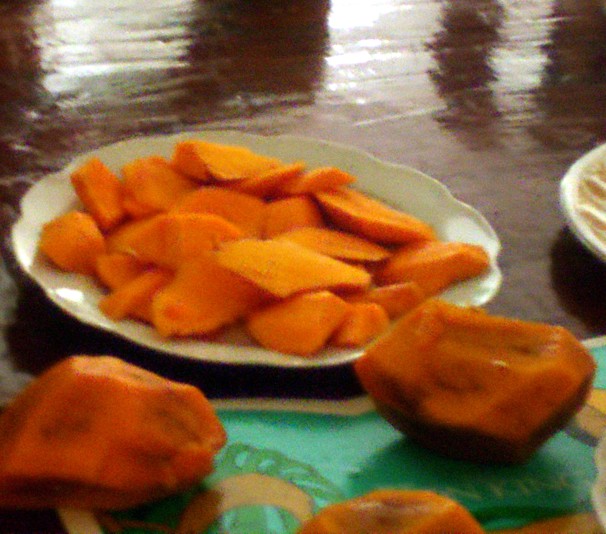 This fruit is two times bigger then the mamey it tastes different and the seed is different. It seems to be known only in the Island of Haiti.
The fruit has huge brown mass on the left on the exterior (resembles the size of a head). The brown spots with the orange pulp is the big seed.
This fruit is two times bigger then the mamey it tastes different and the seed is different. It seems to be known only in the Island of Haiti.
The fruit has huge brown mass on the left on the exterior (resembles the size of a head). The brown spots with the orange pulp is the big seed.
| |||||||
Almendra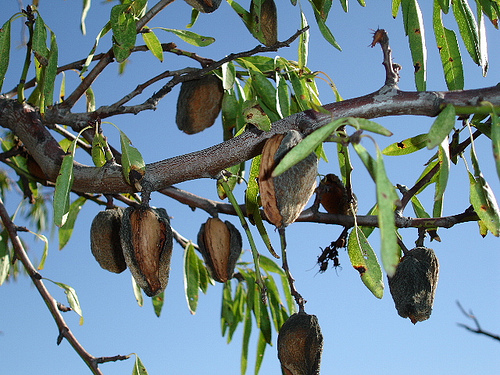 Almendra sounds like almond, but doesn’t look like almonds at all. It has small green fruit that turn yellow. Boys like to chew the outside, but it doesn’t taste very good. When they are dried they can be broken open with a hammer and there is a small cigar shaped seed inside that is tasty.
Almendra sounds like almond, but doesn’t look like almonds at all. It has small green fruit that turn yellow. Boys like to chew the outside, but it doesn’t taste very good. When they are dried they can be broken open with a hammer and there is a small cigar shaped seed inside that is tasty.
| |||||||
Almond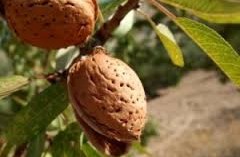 Almond is a large tree (up to 115ft in height), often grown for ornamental purposes and the shade provided by its broad leaves. Parts of the fruit are edible, including the inner seed which resembles almonds in shape and taste.
Almond is a large tree (up to 115ft in height), often grown for ornamental purposes and the shade provided by its broad leaves. Parts of the fruit are edible, including the inner seed which resembles almonds in shape and taste.
Source: http://wiwords.com/word/almond | |||||||
Avocadoes (Aguacates, Alligator Pear, Avocado Pear, Zaboca)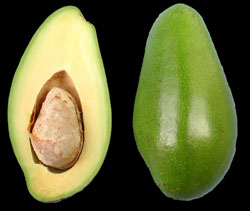 Avocadoe is a pear shaped tropical fruit with green, reddish-purple or blackish skin and rich yellowish pulp enclosing a single
large seed. The skin itself can sometimes be speckled with tiny yellow dots, it may be smooth or pebbled, glossy or dull, thin or leathery, pliable or
granular and brittle. The single seed is round in shape, hard and heavy. An avocado is really ripe when you can hear the seed rattle
if you shake the fruit. The avocado tree usually grow to 30 ft (9 m) but sometimes grow to 60 ft (18 m) or more.
The avocado was first cultivated in Jamaica in 1696 before making it ways to the rest of the Caribbean.
Avocadoe is a pear shaped tropical fruit with green, reddish-purple or blackish skin and rich yellowish pulp enclosing a single
large seed. The skin itself can sometimes be speckled with tiny yellow dots, it may be smooth or pebbled, glossy or dull, thin or leathery, pliable or
granular and brittle. The single seed is round in shape, hard and heavy. An avocado is really ripe when you can hear the seed rattle
if you shake the fruit. The avocado tree usually grow to 30 ft (9 m) but sometimes grow to 60 ft (18 m) or more.
The avocado was first cultivated in Jamaica in 1696 before making it ways to the rest of the Caribbean.
Note: To speed the ripening process, place the avocado in a paper/plastic bag, and store at room temperature until ready to eat (usually two to five days). | |||||||
Balata (Ausubo)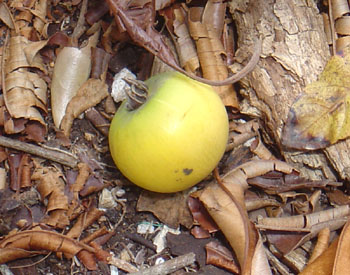 A large tree bearing medium sized, purple/yellow skinned fruits, about two inches across, bearing many similarities to the sapodilla and taste similar to Star Apple
A large tree bearing medium sized, purple/yellow skinned fruits, about two inches across, bearing many similarities to the sapodilla and taste similar to Star Apple
| |||||||
Banana (Bougament - Small Bananas, Figs)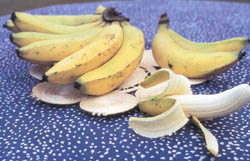 A major income earner in the Caribbean, bananas are also a favourite food in the region.
Green bananas are boiled and eaten as a staple food, while the ripe fruit are eaten raw or incorporated into several tasty recipes such as banana cake, and fritters.
A major income earner in the Caribbean, bananas are also a favourite food in the region.
Green bananas are boiled and eaten as a staple food, while the ripe fruit are eaten raw or incorporated into several tasty recipes such as banana cake, and fritters.
| |||||||
Banga (Grugru Bef)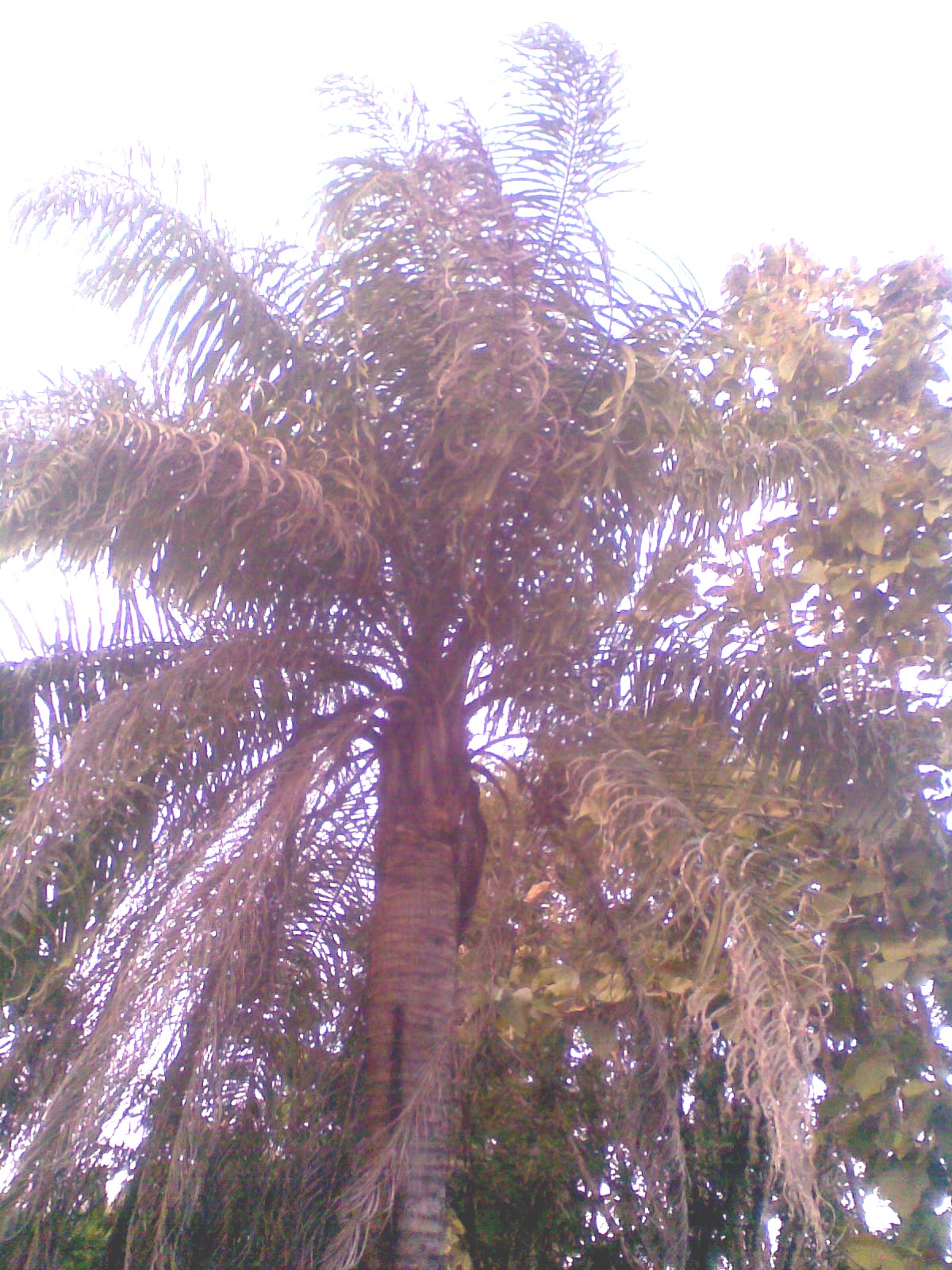 Banga is a tree that grows like a palm tree with a lot of sharp torns covering the area where the a hard shell is found at the flap of tree bark.
When yuh take off the hard shell you find the edible flesh part and below that is a hard nut like a coconut.
Banga is a tree that grows like a palm tree with a lot of sharp torns covering the area where the a hard shell is found at the flap of tree bark.
When yuh take off the hard shell you find the edible flesh part and below that is a hard nut like a coconut.
| |||||||
Barbadine (Granadilla, Parcha)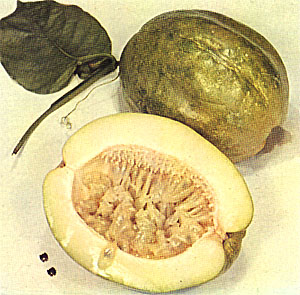 Barbadine is a fast growing vine, arising from a fleshy root that enlarges with age, and can climb to a height of 33 to 50 ft (10-15 m).
The flesh of the ripe fruit, with the inner skin removed can be used as a vegetable or when cooked with sugar,
eaten as an dessert, or be made into a jelly from the unpeeled flesh boiled for 2 hours and the pulp simmered separately. The juice strained from both is combined and, with
added sugar and lemon juice, is boiled until it jells. The young, unripe fruit may be steamed or boiled and served as a vegetable, or may be cut up, breaded and cooked
in butter with milk, pepper and nutmeg.
Barbadine is a fast growing vine, arising from a fleshy root that enlarges with age, and can climb to a height of 33 to 50 ft (10-15 m).
The flesh of the ripe fruit, with the inner skin removed can be used as a vegetable or when cooked with sugar,
eaten as an dessert, or be made into a jelly from the unpeeled flesh boiled for 2 hours and the pulp simmered separately. The juice strained from both is combined and, with
added sugar and lemon juice, is boiled until it jells. The young, unripe fruit may be steamed or boiled and served as a vegetable, or may be cut up, breaded and cooked
in butter with milk, pepper and nutmeg.
| |||||||
Breadfruit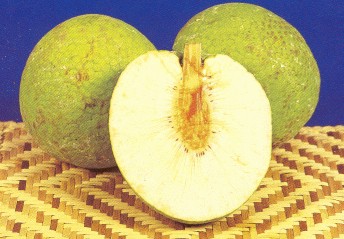 The Breadfruit was originally grown in the South Seas - being a native of Polynesia. The breadfruit is a large tree that grows widely in Jamaica, but was unknown here before 1793. Its arrival is one of Jamaica’s romantic stories.
The first attempt to introduce the breadfruit was made at a time when many slaves were dying of starvation.
The Breadfruit was originally grown in the South Seas - being a native of Polynesia. The breadfruit is a large tree that grows widely in Jamaica, but was unknown here before 1793. Its arrival is one of Jamaica’s romantic stories.
The first attempt to introduce the breadfruit was made at a time when many slaves were dying of starvation.
| |||||||
Brazil Nut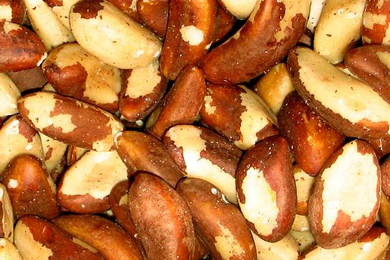 The Brazil nut is a large tree, reaching 50 m (160 ft) tall and with a trunk 1 to 2 m (3.3 to 6.6 ft) in diameter, making it among the largest of trees in the Amazon rainforests. The stem is straight and commonly without branches for well over half the tree's height, with a large emergent crown of long branches above the surrounding canopy of other trees.
The bark is grayish and smooth. The leaves are dry-season deciduous, alternate, simple, entire or crenate, oblong, 20–35 cm (7.9–13.8 in) long and 10–15 cm (3.9–5.9 in) broad. The flowers are small, greenish-white, in panicles 5–10 cm (2.0–3.9 in) long; each flower has a two-parted, deciduous calyx, six unequal cream-colored petals, and numerous stamens united into a broad, hood-shaped mass.
The Brazil nut is a large tree, reaching 50 m (160 ft) tall and with a trunk 1 to 2 m (3.3 to 6.6 ft) in diameter, making it among the largest of trees in the Amazon rainforests. The stem is straight and commonly without branches for well over half the tree's height, with a large emergent crown of long branches above the surrounding canopy of other trees.
The bark is grayish and smooth. The leaves are dry-season deciduous, alternate, simple, entire or crenate, oblong, 20–35 cm (7.9–13.8 in) long and 10–15 cm (3.9–5.9 in) broad. The flowers are small, greenish-white, in panicles 5–10 cm (2.0–3.9 in) long; each flower has a two-parted, deciduous calyx, six unequal cream-colored petals, and numerous stamens united into a broad, hood-shaped mass.
Source (edited): http://en.wikipedia.org/wiki/Brazil_nut | |||||||
Calabash (Huingo, Kalebas, Krabasi)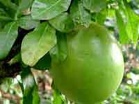 Calabash Tree is a small evergreen tropical tree which can grow up to a height of 25 feet and produce fruits up to 25 cm in diameter. It has simple leaves and the bark of the tree is rough. The fruit is large, hard and green in color and takes about six months to ripen. They cannot be eaten but can be used for various ornamental purposes. The fruits are pollinated by bats and they develop from the trunk of the tree. The seeds of the fruit are flat, small and are embedded in the pulp.
Calabash Tree is a small evergreen tropical tree which can grow up to a height of 25 feet and produce fruits up to 25 cm in diameter. It has simple leaves and the bark of the tree is rough. The fruit is large, hard and green in color and takes about six months to ripen. They cannot be eaten but can be used for various ornamental purposes. The fruits are pollinated by bats and they develop from the trunk of the tree. The seeds of the fruit are flat, small and are embedded in the pulp.
Source: http://www.fruitsinfo.com/calabash-tree-tropical-fruits.php | |||||||
Carailli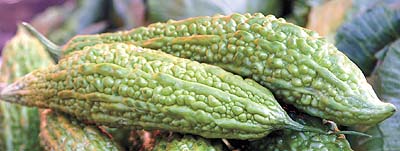 A rough-skinned, cucumber-like fruit, also called bitter melon—is probably one of the most unpopular in the melon family
A rough-skinned, cucumber-like fruit, also called bitter melon—is probably one of the most unpopular in the melon family
| |||||||
Carambola ( Chinese Jimbelin, Chinese Tamrind (Chinese Tambran), Coolie Tamarind, Five Fingers, Starfruit)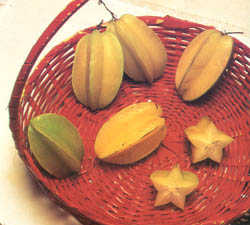 The plant thrives in tropical climates like the West Indies, Florida, Hawaii, Central and South America, Sri Lanka, India, Malaysia, China and other parts of south east Asia. The "Five Fingers" tree attains a height of 30 feet and produces small, fragrant, rose-coloured flowers throughout the year. The tree also produces fruits more than once per year. On the tree the fruit has a variety of appearances. The very ripe fruit has a golden yellow colour; half-ripe its a lemon green and unripe they are very green, all can be eaten. It also has a variety of tastes when eaten raw. The fruit is sweet, watery, slightly acid and pleasant to taste. Five Fingers is also referred to as the "Star Fruit" . When the fruit is cut across it has a striking star shape, hence the reason for the name.
The skin of the fruit is thin and somewhat waxy and there's no need to peel the fruit, although the outer edge of the ribs may be removed if they are bruised.
The plant thrives in tropical climates like the West Indies, Florida, Hawaii, Central and South America, Sri Lanka, India, Malaysia, China and other parts of south east Asia. The "Five Fingers" tree attains a height of 30 feet and produces small, fragrant, rose-coloured flowers throughout the year. The tree also produces fruits more than once per year. On the tree the fruit has a variety of appearances. The very ripe fruit has a golden yellow colour; half-ripe its a lemon green and unripe they are very green, all can be eaten. It also has a variety of tastes when eaten raw. The fruit is sweet, watery, slightly acid and pleasant to taste. Five Fingers is also referred to as the "Star Fruit" . When the fruit is cut across it has a striking star shape, hence the reason for the name.
The skin of the fruit is thin and somewhat waxy and there's no need to peel the fruit, although the outer edge of the ribs may be removed if they are bruised.
| |||||||
Cashew Fruit (Caju, Cajuil, Cajueiro, Cashew Apple, Marańon, Merey, Pajuil)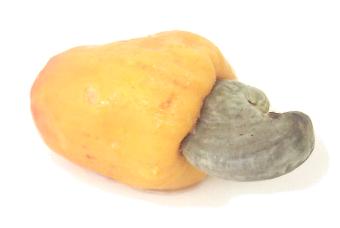 Cashew fruit can grow up to 15 meters (50 feet) tall with thick trunks and branches that reaches the ground. The tree bark and leaves of the cashew tree are used for medical purposes, the roasted cashew nut has international appeal, and the shell around the nut is used in local remedies even though it can be toxic. The cashew nut grows externally in its own kidney shaped hard shell at the end of this stem commonly known as cashew fruit or cashew apple. The cashew apple is the yellowish-orange part that's attached to the fruit When ripe, the fruit turns a bright reddish orange, red or yellow color. The cashew fruits and juice can be used to treat fever and sweeten breath. It leaves a sort of tangy taste in the mouth. The green fruit is used to treat warts and flu, and cashew fruit extracts are
also used in body care products.
Cashew fruit can grow up to 15 meters (50 feet) tall with thick trunks and branches that reaches the ground. The tree bark and leaves of the cashew tree are used for medical purposes, the roasted cashew nut has international appeal, and the shell around the nut is used in local remedies even though it can be toxic. The cashew nut grows externally in its own kidney shaped hard shell at the end of this stem commonly known as cashew fruit or cashew apple. The cashew apple is the yellowish-orange part that's attached to the fruit When ripe, the fruit turns a bright reddish orange, red or yellow color. The cashew fruits and juice can be used to treat fever and sweeten breath. It leaves a sort of tangy taste in the mouth. The green fruit is used to treat warts and flu, and cashew fruit extracts are
also used in body care products.
| |||||||
Cerise (Psidium, Series)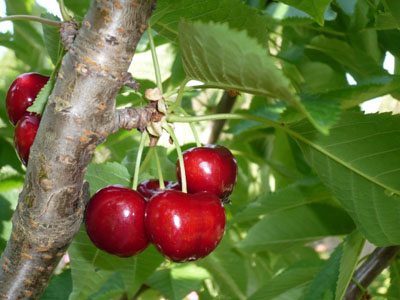 A type of sour cherry with one single seed that is green when green and yellow/red when ripe. This fruit is rolled to soften before eating. It has many many seeds.
A type of sour cherry with one single seed that is green when green and yellow/red when ripe. This fruit is rolled to soften before eating. It has many many seeds.
| |||||||
Cherry (Cereza)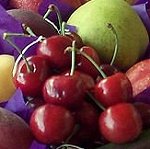 Cherry is a small soft round fruit, red, yellow or black when ripe, containing a stone. The cherry tree grows up to 9m/30 feet. There are three main types of cherries: sweet, sour, and dual purpose. Sweet cherries, fall into two main groups Bigarreaus which have a firm, crisp flesh and are best known by the variety called Napoleons. Napoleons are large pale yellow cherries tinged with light red. Their crisp fragrant flesh is slightly tart. Another is the very popular Bing cherry, which is a large, heart-shaped, deep red fruit with a superb flavour. The second sweet cherry is Geans/Guines has a soft juicy flesh and come in many colours. They are also very fragrant and juicy. The two main types of sour cherry which are too tart to eat raw and must be cooked are Morello
(dark juice - used in confectionary items, jams and desserts) and Amarelle (light and colourless juice - used in a range of dishes; fruit, duck, gâteau to ice creams.) The dual purpose cherries is a mix of sweet and sour flavours. Worldwide cherries are estimated to be in the range of 900 for sweet and 300 for sour. Cherries always have to be picked ripe. They do not ripe well after they have been picked. You can keep cherries for one to three days.
Cherry is a small soft round fruit, red, yellow or black when ripe, containing a stone. The cherry tree grows up to 9m/30 feet. There are three main types of cherries: sweet, sour, and dual purpose. Sweet cherries, fall into two main groups Bigarreaus which have a firm, crisp flesh and are best known by the variety called Napoleons. Napoleons are large pale yellow cherries tinged with light red. Their crisp fragrant flesh is slightly tart. Another is the very popular Bing cherry, which is a large, heart-shaped, deep red fruit with a superb flavour. The second sweet cherry is Geans/Guines has a soft juicy flesh and come in many colours. They are also very fragrant and juicy. The two main types of sour cherry which are too tart to eat raw and must be cooked are Morello
(dark juice - used in confectionary items, jams and desserts) and Amarelle (light and colourless juice - used in a range of dishes; fruit, duck, gâteau to ice creams.) The dual purpose cherries is a mix of sweet and sour flavours. Worldwide cherries are estimated to be in the range of 900 for sweet and 300 for sour. Cherries always have to be picked ripe. They do not ripe well after they have been picked. You can keep cherries for one to three days.
NB: The Barbados cherry (Acerola) is a group of small fruiting trees and shrubs. It is the richest of all fruits for their vitamin C content which is cultivated for medicinal purposes. The fruit is a bright red, about the size of a cherry, with shallow furrows running down the outside, and resembles the three pits which fit closely together inside. The flesh is juicy. Barbados cherry can be use in jams and other preserves, or mixed with other fruits. 'West Indian' cherries (Malpighia punicifolia) are a bit smaller and more tart than the cherries normally available. | |||||||
Chataigne (Breadnut, Katahar)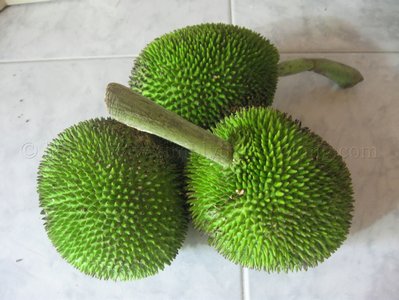 This fruit looks very similar to Breadfruit in its natural form, the only different is that the skin of the Chataigne has a pickery surface while the skin of the Breadfruit is smooth. The skin of both these fruits are vivid green in color.
Once the fruit is cut open, the inside has a white pulp and inside the pulp are brown seeds. These seeds are called the Bread Nut and they are to be separated from the pulp.
When the Bread Nut are cooked, they can be eaten. To eat a Bread Nut, remove the hard casing over it, inside there will be a white looking nut. This is the part that is eaten. After peeling off the hard shell, a thin brown layer (or pieces of it) may remain over the nut. It can be removed or the nut can be eaten like that.
This fruit looks very similar to Breadfruit in its natural form, the only different is that the skin of the Chataigne has a pickery surface while the skin of the Breadfruit is smooth. The skin of both these fruits are vivid green in color.
Once the fruit is cut open, the inside has a white pulp and inside the pulp are brown seeds. These seeds are called the Bread Nut and they are to be separated from the pulp.
When the Bread Nut are cooked, they can be eaten. To eat a Bread Nut, remove the hard casing over it, inside there will be a white looking nut. This is the part that is eaten. After peeling off the hard shell, a thin brown layer (or pieces of it) may remain over the nut. It can be removed or the nut can be eaten like that.
| |||||||
Chironja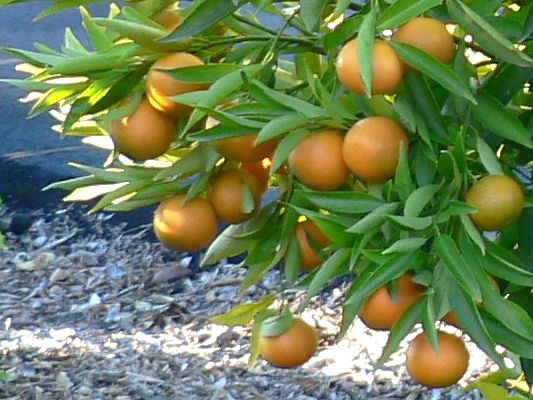 A very delicious juicy citrus that is a cross between an orange and a grapefruit.
A very delicious juicy citrus that is a cross between an orange and a grapefruit.
| |||||||
Cocoa Bean (Cacao Bean)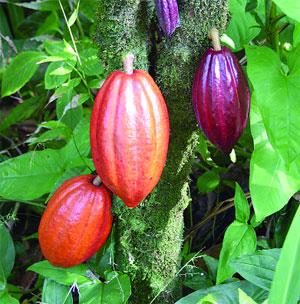 The cocoa bean is the dried and fully fermented fatty seed froma cocoa tree. A cocoa pod (fruit) has a rough and leathery rind about 3 cm (1.2 in) thick (this varies with the origin and variety of pod). It is filled with sweet, mucilaginous pulp (called 'baba de cacao' in South America) enclosing 30 to 50 large seeds that are fairly soft and white to a pale lavender color. While seeds are usually white, they become violet or reddish brown during the drying process. The exception is rare varieties of white cacao, in which the seeds remain white.
The cocoa bean is the dried and fully fermented fatty seed froma cocoa tree. A cocoa pod (fruit) has a rough and leathery rind about 3 cm (1.2 in) thick (this varies with the origin and variety of pod). It is filled with sweet, mucilaginous pulp (called 'baba de cacao' in South America) enclosing 30 to 50 large seeds that are fairly soft and white to a pale lavender color. While seeds are usually white, they become violet or reddish brown during the drying process. The exception is rare varieties of white cacao, in which the seeds remain white.
Source (edited): http://en.wikipedia.org/wiki/Cocoa_bean | |||||||
Coconut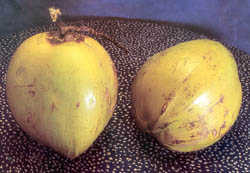 Described as the 'Tree of Heaven', the coconut is so named because almost every part of the crop, from the roots, to the bark, to the fruit, is of some economic
value. Throughout the Caribbean, coconut water is a preferred thirst quencher, while the 'milk' and 'meat' are used in preparing tasty dishes and pastries.
Described as the 'Tree of Heaven', the coconut is so named because almost every part of the crop, from the roots, to the bark, to the fruit, is of some economic
value. Throughout the Caribbean, coconut water is a preferred thirst quencher, while the 'milk' and 'meat' are used in preparing tasty dishes and pastries.
| |||||||
Coco Plum (Hicaco, Fat Pork)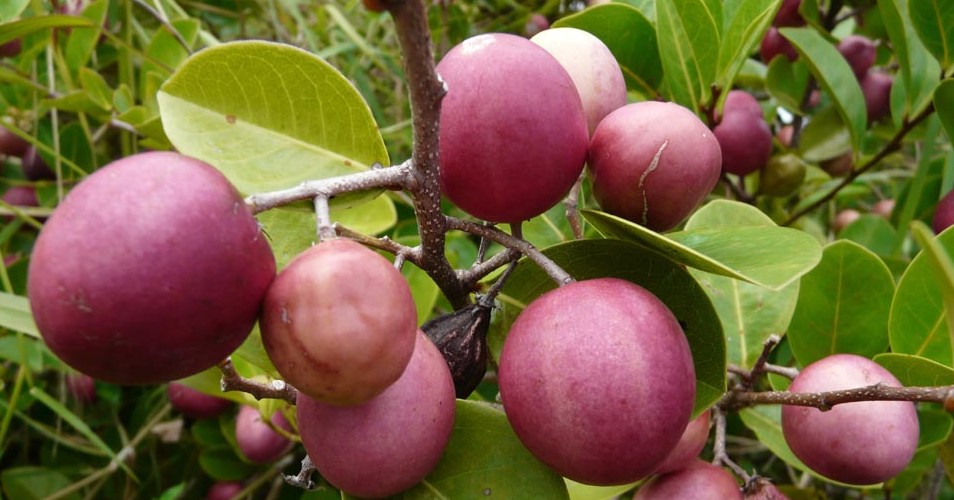 A medium sized shrub or small tree that grows near beaches. The coco plum has a bushy, spreading growth habit and is sometimes trained into hedges. The fruit itself is a Red-purple, plum like fruit with edible white flesh.
A medium sized shrub or small tree that grows near beaches. The coco plum has a bushy, spreading growth habit and is sometimes trained into hedges. The fruit itself is a Red-purple, plum like fruit with edible white flesh.
| |||||||
Cocorite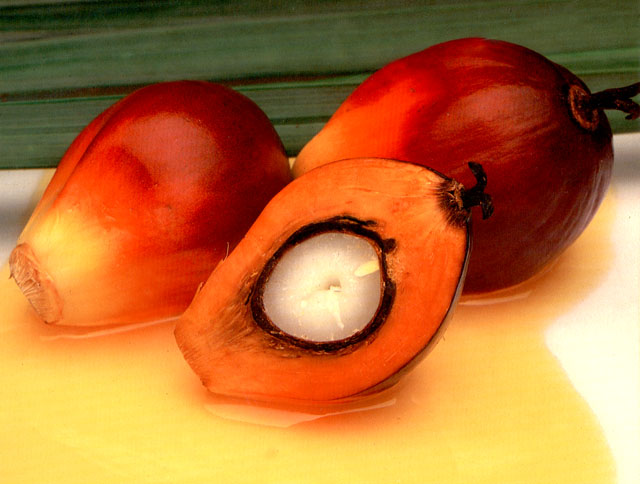 The leaves are used for thatch, the kernels for edible palm oil.
The leaves are used for thatch, the kernels for edible palm oil.for more indept information click here. additional information on click here. | |||||||
Coffee Bean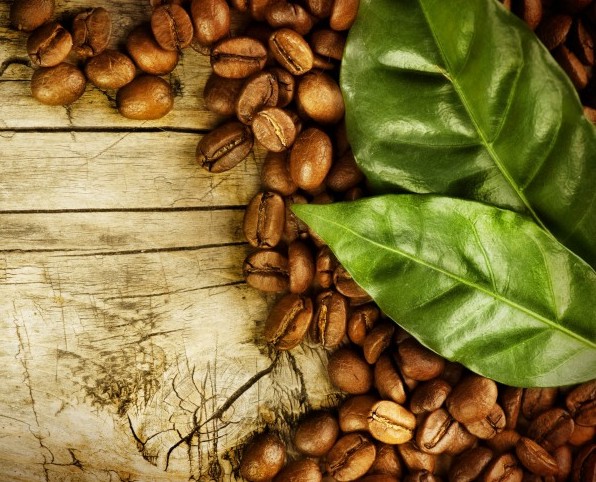 A coffee bean is a seed of the coffee plant, and is the source for coffee. It is the pit inside the red or purple fruit often referred to as a cherry. Even though they are seeds, they are referred to as 'beans' because of their resemblance to true beans. The fruits - coffee cherries or coffee berries - most commonly contain two stones with their flat sides together. A small percentage of cherries contain a single seed, instead of the usual two. This is called a "peaberry."
A coffee bean is a seed of the coffee plant, and is the source for coffee. It is the pit inside the red or purple fruit often referred to as a cherry. Even though they are seeds, they are referred to as 'beans' because of their resemblance to true beans. The fruits - coffee cherries or coffee berries - most commonly contain two stones with their flat sides together. A small percentage of cherries contain a single seed, instead of the usual two. This is called a "peaberry."
Source (edited): http://en.wikipedia.org/wiki/Coffee_bean | |||||||
Coolie Plum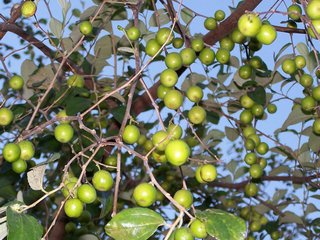 The small reddish fruit comes from a small to medium sized tree that can grow up to 40ft. The hard "nut" inside the fruit contains two seeds
The small reddish fruit comes from a small to medium sized tree that can grow up to 40ft. The hard "nut" inside the fruit contains two seeds | |||||||
Custard Apple (Cachiman, Corazon, Jamaican Apple, Snat Apple, Tjé-Bef)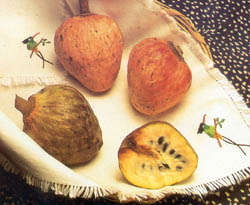 The fruit of the custard apple is heart-shaped with a thin skin that has a pinkish tinge when ripe. The pulp of the fruit is sweet, with a custard-like consistency,
and is either eaten plain or used in making ices or fruit drinks.
The fruit of the custard apple is heart-shaped with a thin skin that has a pinkish tinge when ripe. The pulp of the fruit is sweet, with a custard-like consistency,
and is either eaten plain or used in making ices or fruit drinks.
| |||||||
Date Fruit Tree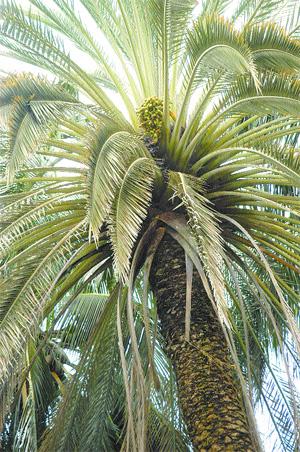 The tree which is normally grows in desert areas such as in the Middle East and are not usually grown in Trinidad. The tree (a palm) is planted from a seed and when fully grown, resembles a palm tree. The fruit is green when young and red when ripe. It takes approximately four months for the fruit to grow and when the date is ready to be eaten, it turns black.
The tree which is normally grows in desert areas such as in the Middle East and are not usually grown in Trinidad. The tree (a palm) is planted from a seed and when fully grown, resembles a palm tree. The fruit is green when young and red when ripe. It takes approximately four months for the fruit to grow and when the date is ready to be eaten, it turns black.
| |||||||
Doung (Aprin, Chinese Jujube, Coolie Plum, Crabapple, Dindoulier, Dunk(s), Gingeolier, Indian Jujube, Liane Croc Chien, Mangustine, Perita Haitiana, Petit Pomme, Pomme Malcadi, Pomme Surette, Yuyubi)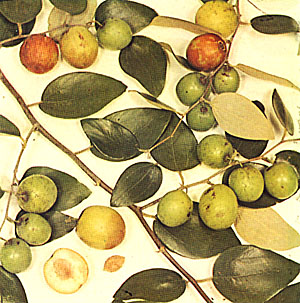 The doung plant is a very active grower and has a rapidly-developing taproot. It may be a bushy shrub 4 to 6 ft (1.2-1.8 m) high, or a tree 10 to 30 or even 40 ft (3-9 or 12 m) tall. It may either be standing tall or wide-spreading, with drooping branches, zigzag branchlets, thornless or with short, sharp straight or hooked spines. It may be evergreen, or leafless for several weeks in hot summers.
The doung plant is a very active grower and has a rapidly-developing taproot. It may be a bushy shrub 4 to 6 ft (1.2-1.8 m) high, or a tree 10 to 30 or even 40 ft (3-9 or 12 m) tall. It may either be standing tall or wide-spreading, with drooping branches, zigzag branchlets, thornless or with short, sharp straight or hooked spines. It may be evergreen, or leafless for several weeks in hot summers.
The leaves are alternate, ovate (egg-shaped)- or oblong-elliptic, 1 to 2 1/2 in (2.5-6.25 cm) long, 3/4 to 1 1/2 in (2-4 cm) wide; distinguished from those of the Chinese jujube by the dense, silky, whitish or brownish hairs on the underside and the short, downy petioles. On the upper surface, they are very glossy, dark-green, with 3 very noticeable, depressed, longitudinal veins, and there are very fine teeth on the margins. The 5-petalled flowers are yellow, tiny, in 2's or 3's in the leaf axils. The fruit of wild trees is 1/2 to 1 in (1.25-2.5 cm) long. With very complex cultivation, the fruit reaches 2 1/2 in (6.25 cm) in length and 1 3/4 in (4.5 cm) in width. The form may be oval, obovate, round or oblong; the skin smooth or rough, glossy, thin but tough, turns from light-green to yellow, later becomes partially or wholly burnt-orange or red-brown or all-red. When slightly under ripe, the flesh is white, crisp, juicy, acid or subacid to sweet, somewhat pungent, much like that of a crabapple. Fully ripe fruits are less crisp and somewhat pale; overripe fruits are wrinkled, the flesh buff-colored, soft, spongy and musky. At first the aroma is apple like and pleasant but it becomes peculiarly musky as the fruit ages. There is a single, hard, oval or oblate, rough central stone which contains 2 elliptic, brown seeds, 1/4 in (6 mm) long. | |||||||
Grapefruit (Shaddock - Pink Grapefruit)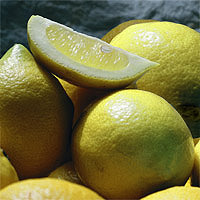 The grapefruit is believed to orignate from Barbados. A large citrus fruit known as a shaddock was brought to the Caribbean from Polynesia. This shaddock was then crossed with the orange (or a citrus) to produce what we now call a "grapefruit".
With a slightly acidic and bitter taste, the "white" grapefruit takes its name from the colour of its flesh. There are also pink or ruby grapefruits and the blood pummelo, which are sweeter. Grapefruit trees are large with glossy dark green leaves and the fruit hangs in clusters
on the tree.
The grapefruit is believed to orignate from Barbados. A large citrus fruit known as a shaddock was brought to the Caribbean from Polynesia. This shaddock was then crossed with the orange (or a citrus) to produce what we now call a "grapefruit".
With a slightly acidic and bitter taste, the "white" grapefruit takes its name from the colour of its flesh. There are also pink or ruby grapefruits and the blood pummelo, which are sweeter. Grapefruit trees are large with glossy dark green leaves and the fruit hangs in clusters
on the tree.
| |||||||
Gri Gri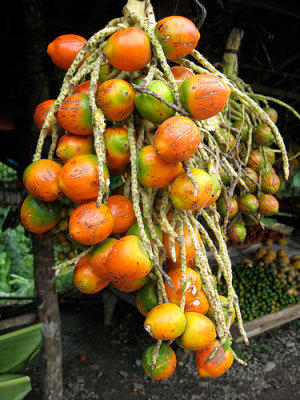 Gri Gri is a small red fruit a little smaller than a marble with a black seed like a coconut. Break the black seed and the nut is very sweet.
Gri Gri is a small red fruit a little smaller than a marble with a black seed like a coconut. Break the black seed and the nut is very sweet.
| |||||||
Guava (Cayan - a large very meaty type)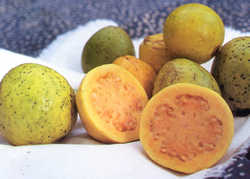 Guava is the authentic Arawak name of this pungently scented fruit which is eaten raw when ripe or used for making the popular Guava Jelly or tinned guava nectar.
The leaves of the tree are used in folk medicine with a popular Jamaican folk song claiming 'Guava root a medicine fe go cure di young gal fever'.
Guava is the authentic Arawak name of this pungently scented fruit which is eaten raw when ripe or used for making the popular Guava Jelly or tinned guava nectar.
The leaves of the tree are used in folk medicine with a popular Jamaican folk song claiming 'Guava root a medicine fe go cure di young gal fever'.
| |||||||
Guinep (Akee, Canep, Chenep, Chennette, Kenip, Kimoncillo, Mapo, Skinip, Spanish Lime, Tjennét)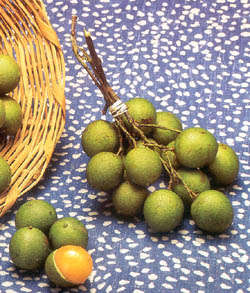 This fruit has a rough but thin skin with soft jelly-like flesh. The slightly tart guinep grows in bunches and are usually eaten a small bunch a time. The pulp is used,
juiced with limes and/or ginger to make a refreshing drink
This fruit has a rough but thin skin with soft jelly-like flesh. The slightly tart guinep grows in bunches and are usually eaten a small bunch a time. The pulp is used,
juiced with limes and/or ginger to make a refreshing drink
| |||||||
Hog Plum (Mombin)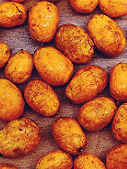 The yellowish plum is related to the mango, cashew, and ambarella.
The yellowish plum is related to the mango, cashew, and ambarella. | |||||||
Jackfruit (Jaca, Jak, Jakfruit)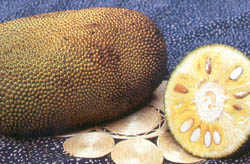 The large, cylindrical shaped jackfruit has a rough skin with which does little to mask the distinctively sweet odour of the succulent pulp inside. It is this pulp that is
eaten, although in some countries the large seeds are cooked and eaten.
The large, cylindrical shaped jackfruit has a rough skin with which does little to mask the distinctively sweet odour of the succulent pulp inside. It is this pulp that is
eaten, although in some countries the large seeds are cooked and eaten.
| |||||||
Jamaica plum (Chile Plum, Governor's Plum, Hog Plum, Purple Mombin, Purple Plum, Red Mombin, Red Plum, Scarlet Plum, Spanish Plum, Wild Plum)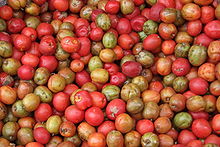 Jamaica plum is a small to medium-sized tree up to 25 feet tall that has an edible fruit. The leaves fall off when they're mature in the short dry season, but only fall shortly before the new leaves develop; they are pinnate, with 7-23 leaflets, each leaflet 3-5 cm long and 1.5-2 cm broad. The flowers are small, reddish-purple, produced in large panicles. The fruit is an edible oval drupe (outer fleshy part), 3-5 cm long and 2-3.5 cm broad, ripening red (occasionally yellow) and containing a single large seed.
Jamaica plum is a small to medium-sized tree up to 25 feet tall that has an edible fruit. The leaves fall off when they're mature in the short dry season, but only fall shortly before the new leaves develop; they are pinnate, with 7-23 leaflets, each leaflet 3-5 cm long and 1.5-2 cm broad. The flowers are small, reddish-purple, produced in large panicles. The fruit is an edible oval drupe (outer fleshy part), 3-5 cm long and 2-3.5 cm broad, ripening red (occasionally yellow) and containing a single large seed.
| |||||||
Jamun Fruit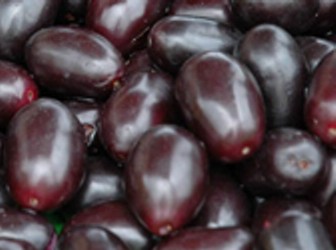 Jamun fruit is an evergreen tropical tree reaching heights up to 30m(98 feet). The wood obtained from the jamun tree is extremely strong and is used in the fabrication of train sleepers.
A Jamun trees flowers from March to April. The flowers are fragrant and small, about 5 mm in diameter. The fruits develop by May or June and are very much like large berries in appearance. The fruit is oblong, ovoid, and green in the initial days, but turns to a crimson black as it matures. The fruit has a sweet, mildly sour and astringent flavour and lends a purple tinge to the tongue when eaten.
Jamun fruit is an evergreen tropical tree reaching heights up to 30m(98 feet). The wood obtained from the jamun tree is extremely strong and is used in the fabrication of train sleepers.
A Jamun trees flowers from March to April. The flowers are fragrant and small, about 5 mm in diameter. The fruits develop by May or June and are very much like large berries in appearance. The fruit is oblong, ovoid, and green in the initial days, but turns to a crimson black as it matures. The fruit has a sweet, mildly sour and astringent flavour and lends a purple tinge to the tongue when eaten.
| |||||||
June Plum (Dew Plum, Golden Apple, Jew Plum, Pommecythere)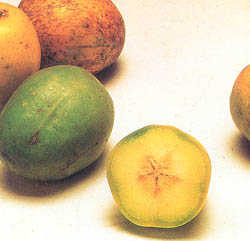 June plum can eaten green or ripe. June plum juice is made by blending the flesh with ginger and sweetening with sugar.
June plum can eaten green or ripe. June plum juice is made by blending the flesh with ginger and sweetening with sugar.
| |||||||
Lay Lay (Manjack)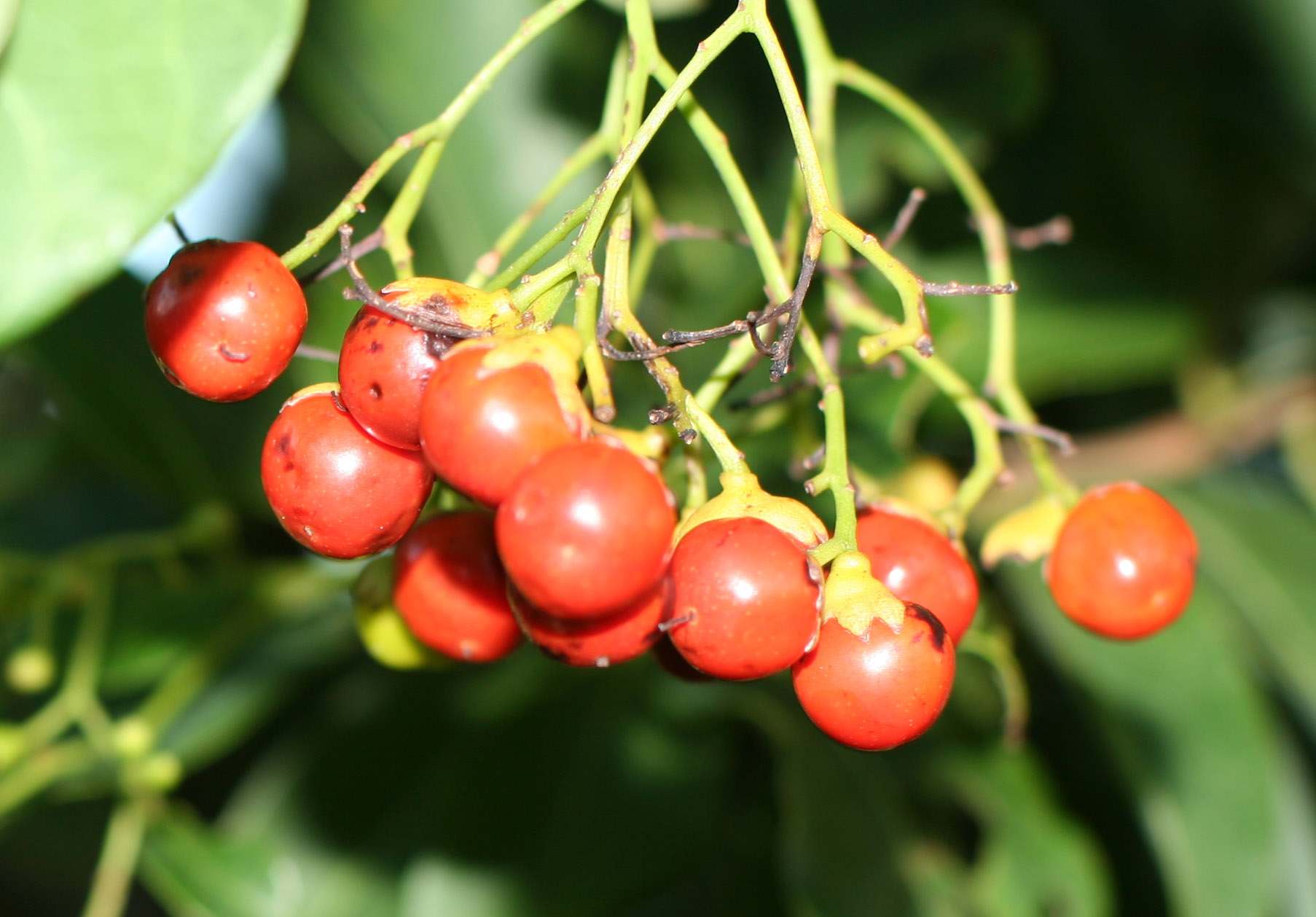 Lay Lay is a red fruit very sweet and has a sticky juice.
Lay Lay is a red fruit very sweet and has a sticky juice.
Image courtesy http://seestjohn.com/st_john_life/tag/st-john/page/10/" | |||||||
Lemon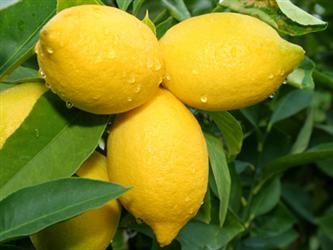 Lemon is a bright yellow citrus fruit is oval in shape, with a pronounced bulge on the blossom end. The flesh is juicy and acidic. The lemon can range in size from that of a large egg to that of a small grapefruit. Some have thin skins while others have very thick rinds, which are used to make candied lemon peel.
Lemon is a bright yellow citrus fruit is oval in shape, with a pronounced bulge on the blossom end. The flesh is juicy and acidic. The lemon can range in size from that of a large egg to that of a small grapefruit. Some have thin skins while others have very thick rinds, which are used to make candied lemon peel.
Source (edited): http://www.foodterms.com/encyclopedia/lemon/index.html Image: http://www.beliefnet.com/Health/Physical-Health/Hidden-Health-Secrets-of-Lemons.aspx | |||||||
Lime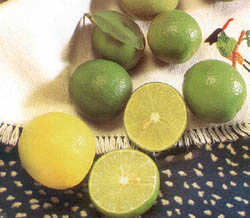 While they are used in much the same way, the small fragrant varieties of limes grown in the Caribbean are not to be confused with lemons. The fruit is used in lemonades while
the leaf is popular as 'lime leaf tea'.
While they are used in much the same way, the small fragrant varieties of limes grown in the Caribbean are not to be confused with lemons. The fruit is used in lemonades while
the leaf is popular as 'lime leaf tea'.
| |||||||
Malay Apple (Mountain Apple)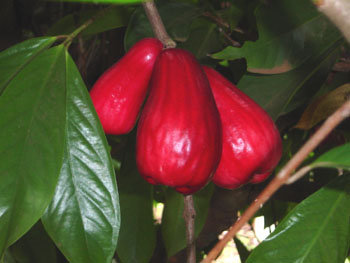 A medium to large sized tree growing to over 60 ft in some areas whereas the fruit is, usually deep red in color, pear shaped, with a waxy skin, about the size of an apple. Flesh is crunchy, often juicy, with a mild sweet flavor. Some varieties have white or pink skin.
A medium to large sized tree growing to over 60 ft in some areas whereas the fruit is, usually deep red in color, pear shaped, with a waxy skin, about the size of an apple. Flesh is crunchy, often juicy, with a mild sweet flavor. Some varieties have white or pink skin.
image courtesy of http://www.tradewindsfruit.com. | |||||||
Mamisiporte (Mammy Apple)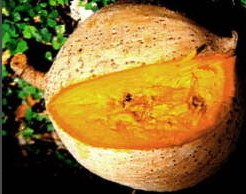 Mamisiporte is a soft fruit the size of an avacado which has a faint smell and taste.
Mamisiporte is a soft fruit the size of an avacado which has a faint smell and taste.
| |||||||
Mango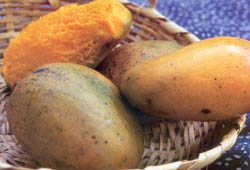 The first mango plants brought to Jamaica arrived in 1782 aboard the HMS Flora - one of Lord Rodney's ships which captured the plant from a French ship on the high seas. There are many
varieties of mango, usually distinguishable by shape and the consistency of the flesh. Eaten ripe, the fruit is aromatic, and the flesh is soft and sweet. Mango is also used to make nectar and
ice-cream.
The first mango plants brought to Jamaica arrived in 1782 aboard the HMS Flora - one of Lord Rodney's ships which captured the plant from a French ship on the high seas. There are many
varieties of mango, usually distinguishable by shape and the consistency of the flesh. Eaten ripe, the fruit is aromatic, and the flesh is soft and sweet. Mango is also used to make nectar and
ice-cream.
| |||||||
Naseberry (Mamey, Níspero, Sapodilla)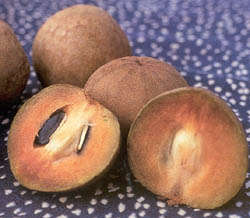 The naseberry is native to Central America and the Caribbean. The Indians of Mexico originally called the tree 'sapodilla', a name that is retained in many parts of the region. The fruit is round in shape
and has a reddish brown skin. When ripe, the fleshy pulp may be eaten or used to make custard and ice-cream. The early Indians chewed the rubbery sap of the tree, which they called 'chicle' and it was this
- with the addition of massive amounts of sugar - that New Yorker Thomas Adams managed to make into successful commercial product - chewing gum.
The naseberry is native to Central America and the Caribbean. The Indians of Mexico originally called the tree 'sapodilla', a name that is retained in many parts of the region. The fruit is round in shape
and has a reddish brown skin. When ripe, the fleshy pulp may be eaten or used to make custard and ice-cream. The early Indians chewed the rubbery sap of the tree, which they called 'chicle' and it was this
- with the addition of massive amounts of sugar - that New Yorker Thomas Adams managed to make into successful commercial product - chewing gum.
| |||||||
Nutmeg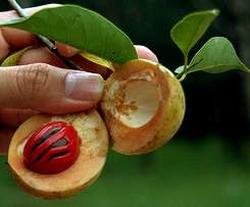 Nutmeg is a spice from the nutmeg tree, which is native to several Indonesian islands and Grenada. Both nutmeg and mace come from the same plant. Nutmeg is the ‘nut’, while mace is the surrounding lacy ‘aril’. Nutmeg has a warm, spicy aroma and flavour and can be used in sweet and savoury cooking. It is a component of the classic béchamel sauce and is used to flavour a host of cakes, puddings and custards.
Nutmeg is a spice from the nutmeg tree, which is native to several Indonesian islands and Grenada. Both nutmeg and mace come from the same plant. Nutmeg is the ‘nut’, while mace is the surrounding lacy ‘aril’. Nutmeg has a warm, spicy aroma and flavour and can be used in sweet and savoury cooking. It is a component of the classic béchamel sauce and is used to flavour a host of cakes, puddings and custards.
Source: http://www.bbc.co.uk/food/nutmeg. | |||||||
Orange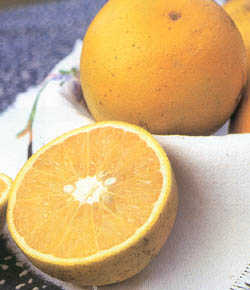 The wide varieties of orange include Valencia, Parson Brown, Hamlin, Navel, Pineapple, Mandarin, Kumquat, King, and other sweet varieties. There is a bitter orange called Seville, which is used for making marmalade. Ortanique, a hybrid combination of orange and tangerine, is popular in Jamaica.
The wide varieties of orange include Valencia, Parson Brown, Hamlin, Navel, Pineapple, Mandarin, Kumquat, King, and other sweet varieties. There is a bitter orange called Seville, which is used for making marmalade. Ortanique, a hybrid combination of orange and tangerine, is popular in Jamaica.
| |||||||
Otaheite Apple (Kwachimelon, Malaba, Malacca Apple, Plum Rose, Pomarosa, Pomme d' Armour, Pommerac, Titi Apple)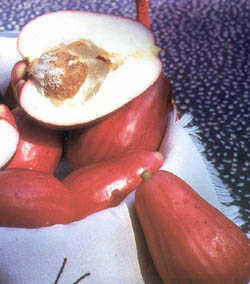 The Otaheite Apple (maple apple) is a native of the Pacific Islands. The juicy, shiny red fruit has one large seed and is usually ovoid shaped. The fruit makes an excellent jam when stewed with brown sugar and ginger.
The Otaheite Apple (maple apple) is a native of the Pacific Islands. The juicy, shiny red fruit has one large seed and is usually ovoid shaped. The fruit makes an excellent jam when stewed with brown sugar and ginger.
| |||||||
Padoo Fruit (Pois Doux, Sweet Pea)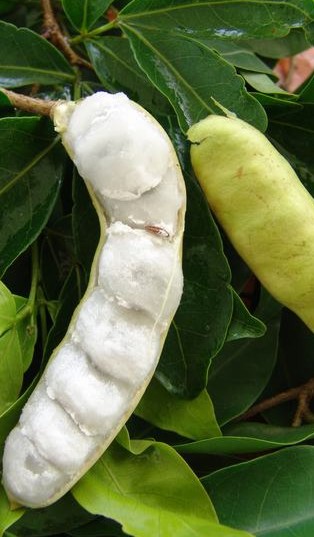 The tree is about the size of a julie mango tree. The flesh of the seed has a melt in your mouth sensation. The tree-growing bean pods contain an edible vanilla-tasting pulp which is traditionally a favorite of children.
The tree is about the size of a julie mango tree. The flesh of the seed has a melt in your mouth sensation. The tree-growing bean pods contain an edible vanilla-tasting pulp which is traditionally a favorite of children.
| |||||||
Passion Fruit (Chinola, Cocktail Fruit, Forbidden Fruit, Maracuya)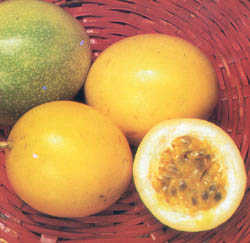 The flavourful translucent sop is scooped out of the hollow husks of the passion fruit for a delightful taste experience. Passion fruit juice is a preferred thirst quencher.
The flavourful translucent sop is scooped out of the hollow husks of the passion fruit for a delightful taste experience. Passion fruit juice is a preferred thirst quencher.
| |||||||
Pawpaw/Paw Paw (Lechosa, Papaya)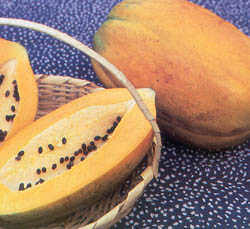 The pawpaw originated in Panama and is indigenous to the Caribbean and Central America. Ripe pawpaw can be served in several ways - the most popular being to cut the unpeeled fruit and remove the seeds, and then use a spoon to scoop out the sweet and juicy flesh. A light sprinkling of lime juice
complements the taste. The ripe fruit may also be processed into juice, puree or jams, while the green fruit is used for sauces and pickles.
The pawpaw originated in Panama and is indigenous to the Caribbean and Central America. Ripe pawpaw can be served in several ways - the most popular being to cut the unpeeled fruit and remove the seeds, and then use a spoon to scoop out the sweet and juicy flesh. A light sprinkling of lime juice
complements the taste. The ripe fruit may also be processed into juice, puree or jams, while the green fruit is used for sauces and pickles.
| |||||||
Peewah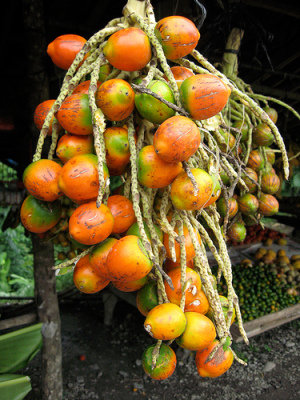 Peewah is a member of the palm (palmaceae) family. Two of its cousins are the gru gru and gri gri. Peewah is grown from a seed and each seed can produce a distinct species of fruit. Peewah cannot be eat raw it must be boiled (cooked) with salt or any selected spices and eaten after the skin is peeled off
The gri gri tree grows to a height about 40 feet. The fruit is a small as marble. When ripe the fruit is red but before that is a light green in color.
The outer red portion that makes the skin of the fruit can be eaten, when the skin is expose it reveals a black seed (nut) which also maybe eaten.
The gru gru tree grow as tall as gri gri cousin. The gru gru fruits is larger and longer then the gri gri. The fruits are round in shape and are the size of a tennis ball. It has light yellow color when ripe and a dark green when unripe. When the when the fleshy part is removed it reveals a nut like its cousin which can be
eaten as well. The gru gru taste like tonka bean or a sapodilla.
Peewah is a member of the palm (palmaceae) family. Two of its cousins are the gru gru and gri gri. Peewah is grown from a seed and each seed can produce a distinct species of fruit. Peewah cannot be eat raw it must be boiled (cooked) with salt or any selected spices and eaten after the skin is peeled off
The gri gri tree grows to a height about 40 feet. The fruit is a small as marble. When ripe the fruit is red but before that is a light green in color.
The outer red portion that makes the skin of the fruit can be eaten, when the skin is expose it reveals a black seed (nut) which also maybe eaten.
The gru gru tree grow as tall as gri gri cousin. The gru gru fruits is larger and longer then the gri gri. The fruits are round in shape and are the size of a tennis ball. It has light yellow color when ripe and a dark green when unripe. When the when the fleshy part is removed it reveals a nut like its cousin which can be
eaten as well. The gru gru taste like tonka bean or a sapodilla.
| |||||||
Penny Piece (Canistel, Egg Fruit, Yellow Cepote)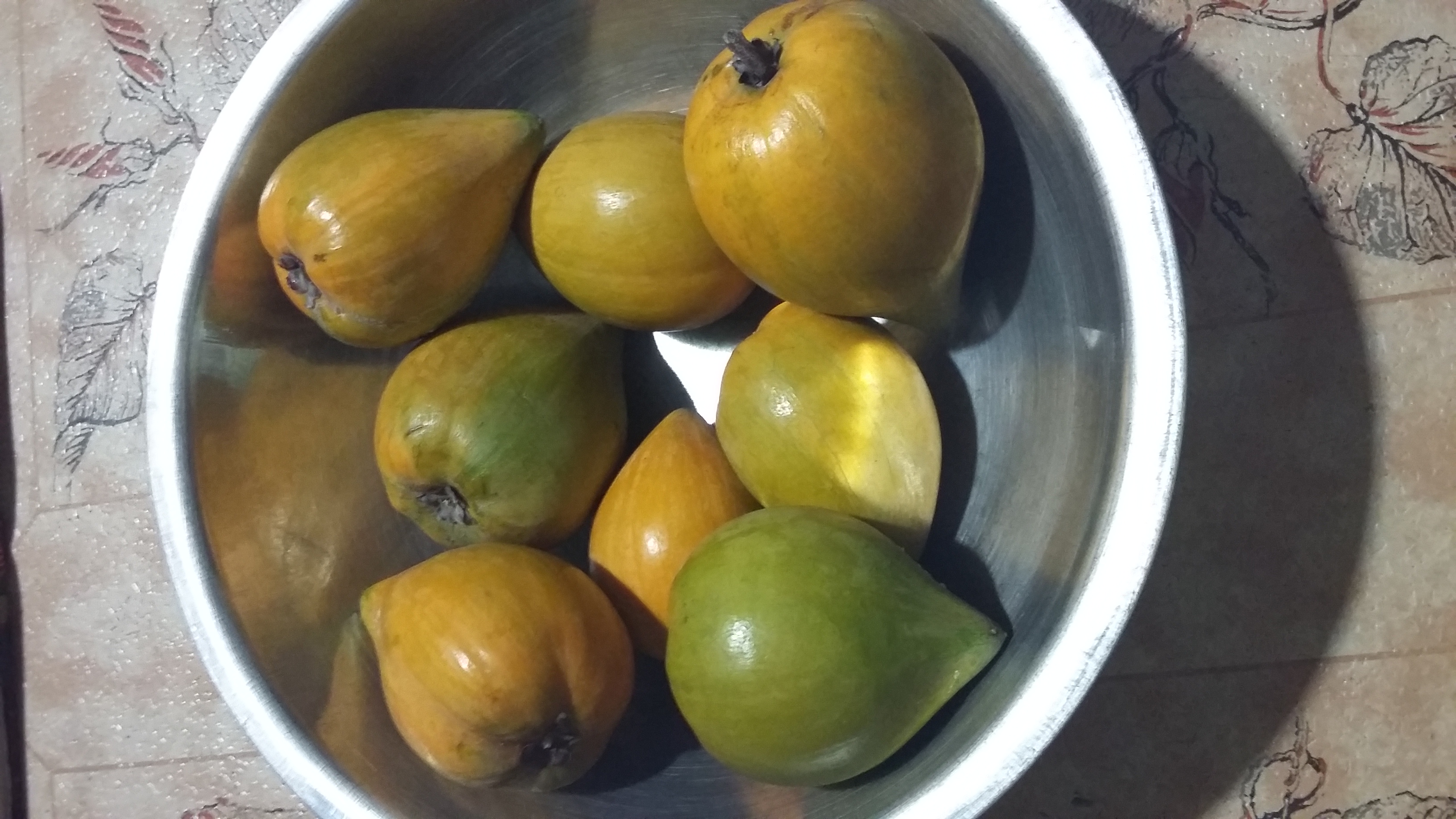 Penny Piece (Canistel) is an edible fruit from the sapote family. Penny Piece will bloom and fruit throughout the year depending on the variety and provide bushels of fruit for the kitchen. The fruit can be eaten fresh of course, but you must wait for the fruit to fully ripen to a soft texture and peel away the thin yellow skin.
Penny Piece can be use as a replacement sweetner for baking, ice creams and other sweet treats.
Penny Piece (Canistel) is an edible fruit from the sapote family. Penny Piece will bloom and fruit throughout the year depending on the variety and provide bushels of fruit for the kitchen. The fruit can be eaten fresh of course, but you must wait for the fruit to fully ripen to a soft texture and peel away the thin yellow skin.
Penny Piece can be use as a replacement sweetner for baking, ice creams and other sweet treats.
| |||||||
Pineapple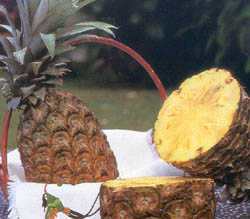 This popular fruit is a native of Central and South America and was introduced to the West Indies by the Spanish who also took the plant to Europe. Pineapples can be eaten or crushed to make juice. The fruit is as an ingredient or garnish in many cocktails.
This popular fruit is a native of Central and South America and was introduced to the West Indies by the Spanish who also took the plant to Europe. Pineapples can be eaten or crushed to make juice. The fruit is as an ingredient or garnish in many cocktails.
| |||||||
Plums Plum is a soft round smooth-skinned sweet fruit with sweet flesh and a flattish pointed stone. A plum is a fruit type with a lot of varieties. They vary in season, size, colour and taste. The plum tree grows 5 to 7m. (16 to 23 feet) high and has greenish-white flower leaves.
There are more than 200 cultivars and consist of four main types of plums: European plums, Japanese plums, the Damsons & Mirabelles and the "cherry-plums" (a native plum sometimes picked wild). Plums are also used for its juice and for making jam, jellies or a thick syrup.
Plum is a soft round smooth-skinned sweet fruit with sweet flesh and a flattish pointed stone. A plum is a fruit type with a lot of varieties. They vary in season, size, colour and taste. The plum tree grows 5 to 7m. (16 to 23 feet) high and has greenish-white flower leaves.
There are more than 200 cultivars and consist of four main types of plums: European plums, Japanese plums, the Damsons & Mirabelles and the "cherry-plums" (a native plum sometimes picked wild). Plums are also used for its juice and for making jam, jellies or a thick syrup.
NB: a prune is a dried plum; | |||||||
Pomegranate (Chinese Apple)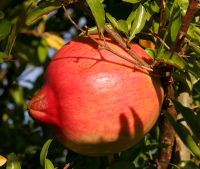 Pomegranate (Punica granatum), showing persistent calyx at top of fruit. The calyx is cut away on right fruit to show the numerous stamens. The fruit is technically a leathery-skinned berry containing many seeds, each surrounded by a fleshy, juicy aril. The pomegranate tree is native to Africa, Caribbean and the Near East.
Hebrews decorated their buildings with pomegranate motifs, and the beautiful, many-seeded fruits became associated with a symbol of fertility and abundance. In Asia, pomegranates were offered to wedding guests who threw them on the floor of the honeymoon suite, shattering the fruits and scattering the bright red seeds. This practice
was believed to insure fertility and a large number of offspring for the newlyweds. The French word for a pomegranate is "grenade," which also refers to a hand-thrown bomb that scatters deadly metal fragments (shrapnel) instead of seeds.
Pomegranate (Punica granatum), showing persistent calyx at top of fruit. The calyx is cut away on right fruit to show the numerous stamens. The fruit is technically a leathery-skinned berry containing many seeds, each surrounded by a fleshy, juicy aril. The pomegranate tree is native to Africa, Caribbean and the Near East.
Hebrews decorated their buildings with pomegranate motifs, and the beautiful, many-seeded fruits became associated with a symbol of fertility and abundance. In Asia, pomegranates were offered to wedding guests who threw them on the floor of the honeymoon suite, shattering the fruits and scattering the bright red seeds. This practice
was believed to insure fertility and a large number of offspring for the newlyweds. The French word for a pomegranate is "grenade," which also refers to a hand-thrown bomb that scatters deadly metal fragments (shrapnel) instead of seeds.
The leaves are opposite or sub-opposite, glossy, narrow oblong, entire, 3–7 cm long and 2 cm broad. The flowers are bright red, 3 cm in diameter, with four to five petals (often more on cultivated plants). The fruit is between a lemon and a grapefruit in size, 5–12 cm in diameter with a rounded hexagonal shape, and has thick reddish skin and around 600 seeds.[5] The seeds and surrounding pulp, ranging in colour from white to deep red, called arils, are edible; indeed, the fruit of the pomegranate is a berry. There are some cultivars which have been introduced that have a range of pulp colours such as purple. | |||||||
| Primrose A yellow fruit with crisp flesh and a large hollow cavity containing a single seed. The fruit has a strong fragrance reminiscent of rose water. The trees tend to grow in shaded valleys and close to rivers. Source: http://wiwords.com/word/primrose | |||||||
Rose Apple (Bell Apple, Malabar Plum, Malay Apple, Plum Rose, Sumutoo, Water Apple, Wax Apple)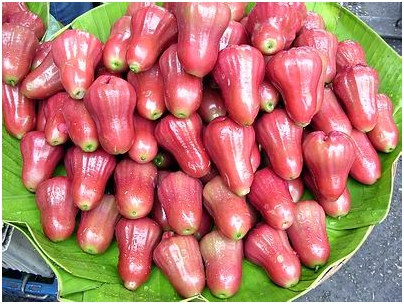 Rose Apple are fruits that are about 5 cm long with a whitish-green color, but color variations exist including red skinned fruits. The skin is thin and waxy.
Rose Apple are fruits that are about 5 cm long with a whitish-green color, but color variations exist including red skinned fruits. The skin is thin and waxy.
| |||||||
Sea Grapes (Uva de Playa) They are small purplish berries, about the size of a small grape, and with a single large seed. There's not much fruit on it, and it tastes vaguely like a grape, with a salty and slightly bitter taste. Sea grapes grow close to the sea, or salt water bodies, very rarely do they grow inland.
They are small purplish berries, about the size of a small grape, and with a single large seed. There's not much fruit on it, and it tastes vaguely like a grape, with a salty and slightly bitter taste. Sea grapes grow close to the sea, or salt water bodies, very rarely do they grow inland.
| |||||||
Sorrel (Roselle)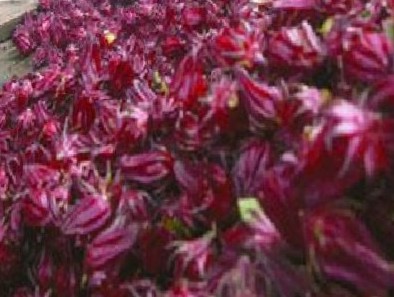 The sorrel plant is a member of the hibiscus family and according to folklore yields its flowers just in time for the Christmas season. The plant has dark green leaves with the red stems and yellow hibiscus-like flowers with deep red bloches at the base. The flowers, fruits and leaves of the sorrel are all edible.
The seeds likewise may be eaten. They are best roasted or ground for making flour for baking. In the Caribbean however, the fruits are brewed to make a tea and also used in salads, jellies, sauces, soups, jams, beverages, chutneys, pickles, tarts, puddings, syrups and wine. In addition sorrel used as medication, the heated
leaves are applied to cracks in the feet and on boils and ulcers. A lotion made from the leaves is used on sores and wounds. There are several varieties of the plant namely the "Rico", "Victor" and "Archer".
The sorrel plant is a member of the hibiscus family and according to folklore yields its flowers just in time for the Christmas season. The plant has dark green leaves with the red stems and yellow hibiscus-like flowers with deep red bloches at the base. The flowers, fruits and leaves of the sorrel are all edible.
The seeds likewise may be eaten. They are best roasted or ground for making flour for baking. In the Caribbean however, the fruits are brewed to make a tea and also used in salads, jellies, sauces, soups, jams, beverages, chutneys, pickles, tarts, puddings, syrups and wine. In addition sorrel used as medication, the heated
leaves are applied to cracks in the feet and on boils and ulcers. A lotion made from the leaves is used on sores and wounds. There are several varieties of the plant namely the "Rico", "Victor" and "Archer".
| |||||||
Sour Cherry (Barbados Cherry (Acerola), Garden Cherry, Puerto Rico Cherry, Native Cherry, West Indian Cherry)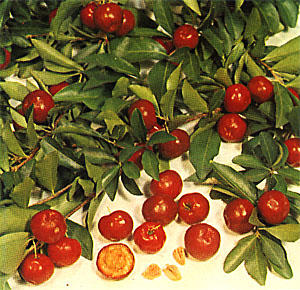 Sour Cherry is a fruit that is a bright red, about the size of a cherry, with shallow furrows running down the outside, indicative of the three pits which fit closely together inside.
The flesh is juicy, and the flavour is slightly acidic, more like a raspberry than a cherry. The fruit does gives a good flavour to jams and other preserves, or when mixed with other fruits. After it is cooked, it tastes more like a tart apple.
The sour cherry bears a strong resemblance to the common cherry. It grows on a thick bush that is sometimes used as a hedge in tropical and subtropical climates.
Sour Cherry is a fruit that is a bright red, about the size of a cherry, with shallow furrows running down the outside, indicative of the three pits which fit closely together inside.
The flesh is juicy, and the flavour is slightly acidic, more like a raspberry than a cherry. The fruit does gives a good flavour to jams and other preserves, or when mixed with other fruits. After it is cooked, it tastes more like a tart apple.
The sour cherry bears a strong resemblance to the common cherry. It grows on a thick bush that is sometimes used as a hedge in tropical and subtropical climates.
| |||||||
Sour Sop (Guanabana - Graviola (english), Kówósól)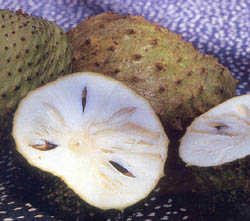 The soursop is ovoid in shape, covered with short , soft spines dark green in colour, changing to a pale green when ripe. The pulp of the fruit is white, of a 'woolly' texture and pleasantly acidic. The juice is used to make a delightful ice cream or iced drink.
The soursop is ovoid in shape, covered with short , soft spines dark green in colour, changing to a pale green when ripe. The pulp of the fruit is white, of a 'woolly' texture and pleasantly acidic. The juice is used to make a delightful ice cream or iced drink.
| |||||||
Star Apple (Caimate/Caimite, Caimito)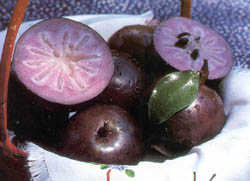 The Star Apple is a native of the Greater Antilles, including Jamaica, and was introduced from these islands to the rest of the tropical world. When cut crossways, the fruit reveals a star-shaped pattern. Star Apple is frequently combined with oranges and condensed milk to form a dessert called 'Matrimony'.
The Star Apple is a native of the Greater Antilles, including Jamaica, and was introduced from these islands to the rest of the tropical world. When cut crossways, the fruit reveals a star-shaped pattern. Star Apple is frequently combined with oranges and condensed milk to form a dessert called 'Matrimony'.
| |||||||
Stinking Toe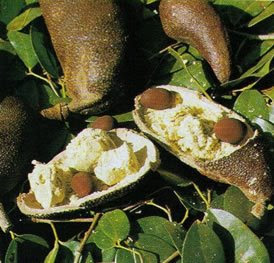 Stinking Toe is a tree and fruit common to the Caribbean, Central, and South America. It is a hardwood that is used for furniture, flooring and decorative purposes. Its sap is utilized in perfumes and varnishes. It is known for it's malodourous fruit which has a hard shell protecting edible pulp.
Stinking Toe is a tree and fruit common to the Caribbean, Central, and South America. It is a hardwood that is used for furniture, flooring and decorative purposes. Its sap is utilized in perfumes and varnishes. It is known for it's malodourous fruit which has a hard shell protecting edible pulp.
Source: http://wiwords.com/word/stinkin-toe | |||||||
Sugar Cane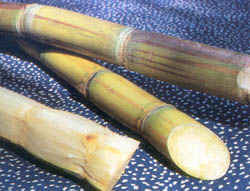 It was sugar which brought African slaves to the West Indies as well as the indentured labour of Indians and Chinese. The diverse inter-racial mix of the region is related to sugar cane and the part it has played in our history. Sugar cane is eaten raw, crushed to make cane juice, and of course processed into white rum.
It was sugar which brought African slaves to the West Indies as well as the indentured labour of Indians and Chinese. The diverse inter-racial mix of the region is related to sugar cane and the part it has played in our history. Sugar cane is eaten raw, crushed to make cane juice, and of course processed into white rum.
| |||||||
Sweet Sop (Anon, Casuma, Chirimoya, Kasheema, Kasuma, Sugar Apple)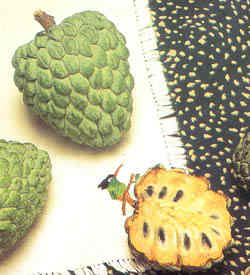 This heart shaped fruit has a peculiar appearance - the entire surface being divided into small, knobbly scales that break away separately when the fruit is ripe, exposing the creamy, sweet custard-like pulp which encloses small black seeds.
This heart shaped fruit has a peculiar appearance - the entire surface being divided into small, knobbly scales that break away separately when the fruit is ripe, exposing the creamy, sweet custard-like pulp which encloses small black seeds.
| |||||||
Tamarind (Tambrin, Tamran)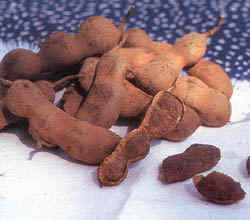 The segmented pod of the tamarind hardens on maturity into a brittle shell which houses three or four small seeds embedded in a tart pulp. The pulp is mixed with sugar to make tamarind balls, a popular confectionery, and can also be mixed with water, and sugar or honey to make a rich drink.
The segmented pod of the tamarind hardens on maturity into a brittle shell which houses three or four small seeds embedded in a tart pulp. The pulp is mixed with sugar to make tamarind balls, a popular confectionery, and can also be mixed with water, and sugar or honey to make a rich drink.
Tangerine (Mandarin, Portugal/Purty Gal (Pretty Girl), King Orange) | 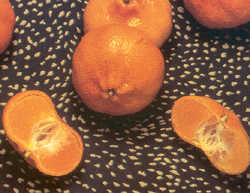 A member of the citrus family, tangerines have a rougher more pliable skin than oranges which does not require peeling and which can be easily broken to reveal the large, juicy pegs inside.
A member of the citrus family, tangerines have a rougher more pliable skin than oranges which does not require peeling and which can be easily broken to reveal the large, juicy pegs inside.
Tipitambo (Lerenes, Guinea Arrowroot, Sweet Corn Root, Tambu, Topinambur, Topitambo, Touple Nambours) | 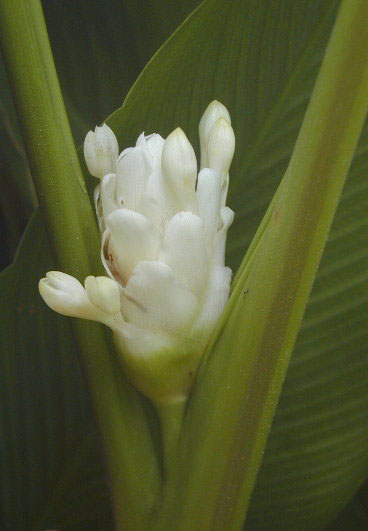 Tipitambo beter known as guinea arrowroot or sweet corn root is the size of a lolipop and the flesh is white and has a crunch like a water chestnut and a lovely nutty taste like a cross between a water chestnut and a new potato when they are boiled.
The plant that grows up to 5 feet (1.5 m) tall with leaves. It has edible tuber roots that are 0.5-2 inches (1-5 cm) long and 0.2-1.2 inches (0.5-3 cm) wide. The tuberous roots of guinea arrowroot are eaten cooked and their texture remains crisp even after long cooking,
which can be used as an ingredient of salads, mayonnaise and fish dishes.
Tipitambo beter known as guinea arrowroot or sweet corn root is the size of a lolipop and the flesh is white and has a crunch like a water chestnut and a lovely nutty taste like a cross between a water chestnut and a new potato when they are boiled.
The plant that grows up to 5 feet (1.5 m) tall with leaves. It has edible tuber roots that are 0.5-2 inches (1-5 cm) long and 0.2-1.2 inches (0.5-3 cm) wide. The tuberous roots of guinea arrowroot are eaten cooked and their texture remains crisp even after long cooking,
which can be used as an ingredient of salads, mayonnaise and fish dishes.
Tanko Bean (Cumaru, Kumaru) | Tanko Bean which is a species of flowering tree in the pea family, that is native to the Orinoco region of northern South America. Its seeds are known as tonka beans. They are black and wrinkled and have a smooth, brown interior. Their fragrance is reminiscent of vanilla, almonds, cinnamon, and cloves. Source: http://wiwords.com/word/tanko-bean Water Lemon (Passiflora Laurifolia) | 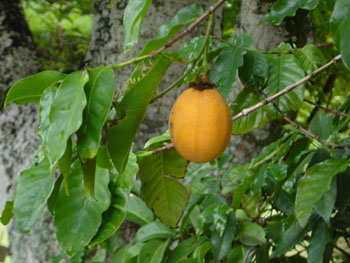 Medium sized, ovaloid fruit, usually with a deep orange skin and white-yellow, extremely juicy pulp.
The water lemon has an excellent perfumy-mild taste, without the tartness of the common passion fruit.
A not widely known, and very underrated passion fruit.
Medium sized, ovaloid fruit, usually with a deep orange skin and white-yellow, extremely juicy pulp.
The water lemon has an excellent perfumy-mild taste, without the tartness of the common passion fruit.
A not widely known, and very underrated passion fruit.
image courtesy of www.tradewindsfruit.com. Watermelon (Sandia) | 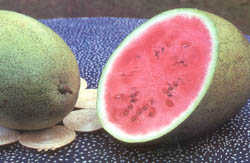 A relative of the cantaloupe, the watermelon provides an overwhelmingly juicy mouthful with every bite. The fruit is also blended into a refreshing drink.
A relative of the cantaloupe, the watermelon provides an overwhelmingly juicy mouthful with every bite. The fruit is also blended into a refreshing drink.
Video | Trinidad &Tobago Fresh Fruits If any one has any more information on these fruits or an images, Banga, or Peewah, or you would like to add a fruit item to this page that I maybe missing.......please email me the fruit name, information and image. Thanks for your input! | |
This site uses frames, if you do not see frames (menu on the left) click here.
Page maintained by www.tntisland.com, Copyright © 1996-2025 Last Revised: 06/01/2025.
